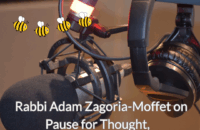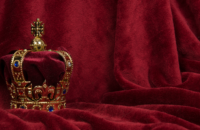Abraham Abulafia

Here’s a riddle for you: who is both a Maimonidean and a Kabbalist, both an ascetic and a Messiah-claimant, both extremely-influential and yet nearly unknown? There’s only one person that fits the bill, and his life is even stranger than any riddle could suggest: Rabbi Abraham Abulafia.
Abulafia was a member of one of medieval Spain’s most illustrious Jewish families, but his path in life diverged considerably from the court-politics of his cousins and relatives. He was from Zaragoza, born in 1240, in what was then Muslim-dominated Spain. He seems to have had a normal upbringing for a well-heeled Jewish youth of the time: a considerable education in Greek and Arabic philosophy, rhetoric, Tanakh, Talmud, and language. Yet, when his father died as he reached maturity, he left all of that behind at the age of 20 to wander the world, and ultimately, to change it.
He first went to the Land of Israel, imagining a mythological paradise but finding himself instead immersed in the aftermath of the Crusades. He made it no further than the northern port of Akko before being caught up in the wars and anarchy that dominated the area at the time and fleeing back across the Mediterranean to Greece. He intended to go to Rome, but washed ashore instead in Capua, where an enigmatic philosopher/mystic from Verona named Hillel was teaching a mystical interpretation of Maimonides’ Guide for the Perplexed. Hillel, like others, suggested that Maimonides had hidden deeper truths in his famous and controversial book (Maimonides claims the same in the introduction), and that it could actually form the basis of a spiritual and mystical system.
This form of mysticism focused on using one’s intellect to connect with God, through contemplation and meditation. The goal was to receive the spirit of prophecy as the Biblical prophets had. It was around this time that Abulafia started having mystical visions, which thankfully, he meticulously documented in his journals, some of which have been preserved. This new spiritual life drove him back to Spain, but this time to Christian-dominated Barcelona. There he studied with mystics who proposed that the Hebrew alphabet itself could be decoded and used as a key to awaken prophecy. By permuting the letters and by elaborate sequences of meditations, movement, self-denial, and isolation, one could connect with God and hear the divine voice.
The goal, of course, was to see beyond the veil of reality, to get a glimpse into God’s mind, and this became Abulafia’s obsession. He tried repeatedly to teach students his method of letter-mysticism but most disappointed him. Many who were mystically-inclined were being swayed by the nascent influence of the Zohar, which promoted mythology over meditation. Abulafia had no time for the baroque complexity of the Zohar, and even suggested that the mystics involved in its writing and dissemination were worse than the Christians, because while the Christians had a three-part God, the Zohar-style mystics had a 10-part God (via the Sefirot).
His sense of alienation ever acute, he increasingly became more isolated. This was his advice for prophecy (complete isolation for days, no eating or speaking, dressing in pure white cloth and meditating for hours on the letters), but it was also a feature of his idiosyncratic mystical approach. His alienation even made him believe that he might be the Messiah (who isn’t, really), and to prove it, he went to the Vatican in 1280 to try to convert the Pope. As you may guess, the Pope (Nicholas III) wasn’t too keen on this idea and instead ordered Abulafia executed, but on his way to the gallows, Nicolas III died suddenly and Abulafia was freed.
After his failed Roman holiday, he fled to Sicily, then and now quite a rural place. However, his attempt at Messiah-ship got him into trouble with the rabbis of the time, and he eventually had to flee to even more desolate surroundings, the isle of Comino in Malta. Even today, Comino has a population of three, so in 1290 when he arrived, Abulafia likely had the place to himself. He continued his meditation and his attempts at prophecy, writing several books which miraculously made it to other communities and were preserved in manuscript. All trace of him disappears by 1300, but we have no idea if he died on Comino or went somewhere even farther afield still.
Abulafia’s strange life illustrates an important truth: Kabbalah, like all of Judaism, is not a monolithic entity. The Zohar, while the most successful school of thought in 13th century Jewish mysticism, was not the only one, and thanks to efforts today to typeset and publish Abulafia’s manuscripts, there has been a renaissance of interest in this unorthodox and iconoclastic prophetic mystic. Abulafia’s work provides a vision of Jewish mysticism which is free of the bizarre borderline-pagan impulses of the Zohar and which blends well with the Maimonidean rationalism he began his career studying. Yet, what he asks of us is tremendous. Though to be fair, if the goal is to receive insight into the Divine mind, you’d better expect the curriculum will be demanding. We shouldn’t expect anything less from one of Jewish history’s most colourful and creative mystical thinkers.
Rabbi Adam Zagoria-Moffet is rabbi of St Albans Masorti Synagogue




